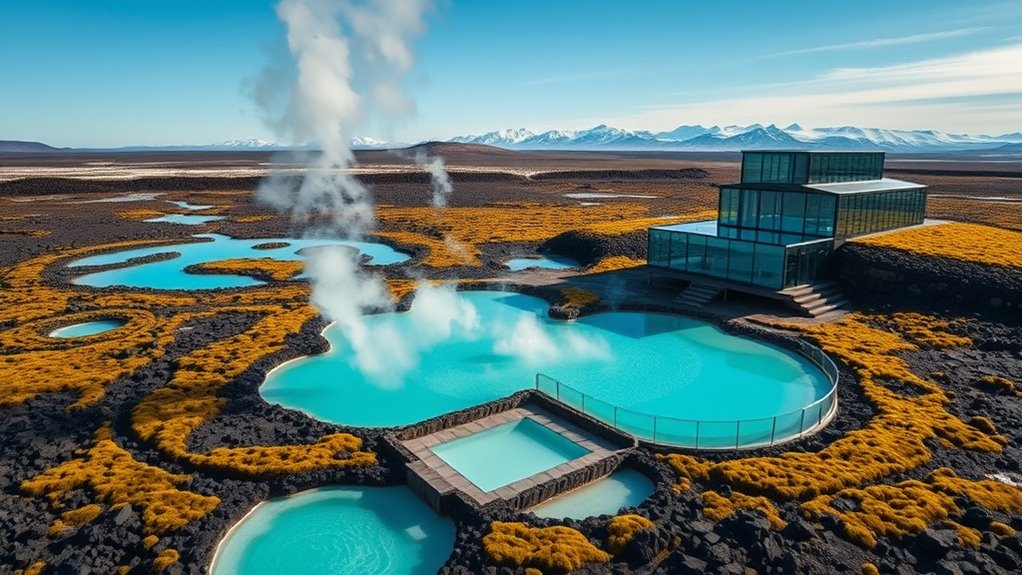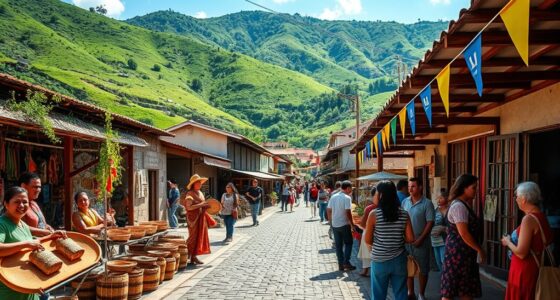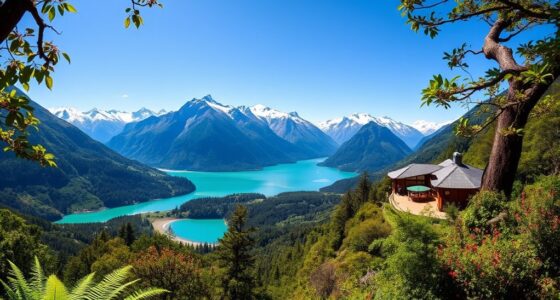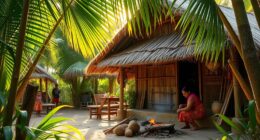In Iceland, geothermal energy fuels luxury retreats, creating a unique blend of comfort and sustainability. You’ll find cozy accommodations heated by natural springs, alongside gourmet dining that showcases local ingredients. These eco-friendly practices not only minimize ecological footprints but also enrich your travel experience with authenticity. As you explore the beauty of geothermal regions, you’ll uncover how this renewable energy source plays a significant role in the hospitality sector and beyond. There’s much more to discover!
Key Takeaways
- Luxury retreats in Iceland utilize geothermal heating, providing eco-friendly comfort and reducing reliance on fossil fuels.
- Unique furniture made from repurposed fishing boats enhances the sustainable luxury experience in these retreats.
- Michelin-starred restaurants at luxury accommodations feature locally sourced ingredients, emphasizing sustainability and authenticity.
- Geothermal energy supports the tourism sector, fostering economic growth and promoting environmental awareness among travelers.
- The combination of geothermal features and luxury amenities creates distinctive experiences that attract eco-conscious luxury travelers.
The Role of Geothermal Energy in Iceland’s Economy

As Iceland has embraced geothermal energy, it’s transformed its economy in remarkable ways.
You’ll notice a significant reduction in dependence on imported fossil fuels, which leads to substantial savings. Between 1950 and 2016, geothermal energy saved an average of 2.6% of the GDP annually. This stability means you won’t face the price fluctuations that come with oil, benefiting both consumers and businesses alike.
The geothermal district heating system contributes up to 7% of GDP, translating to about $3,000 per person annually. Moreover, by minimizing CO2 emissions—around 8.5 million tonnes each year—Iceland not only leads in renewable energy but also strengthens its tourism sector. This sustainable approach keeps capital within the country, boosting long-term economic health and providing significant financial relief for Icelandic citizens.
Luxury Retreats Powered by Geothermal Energy
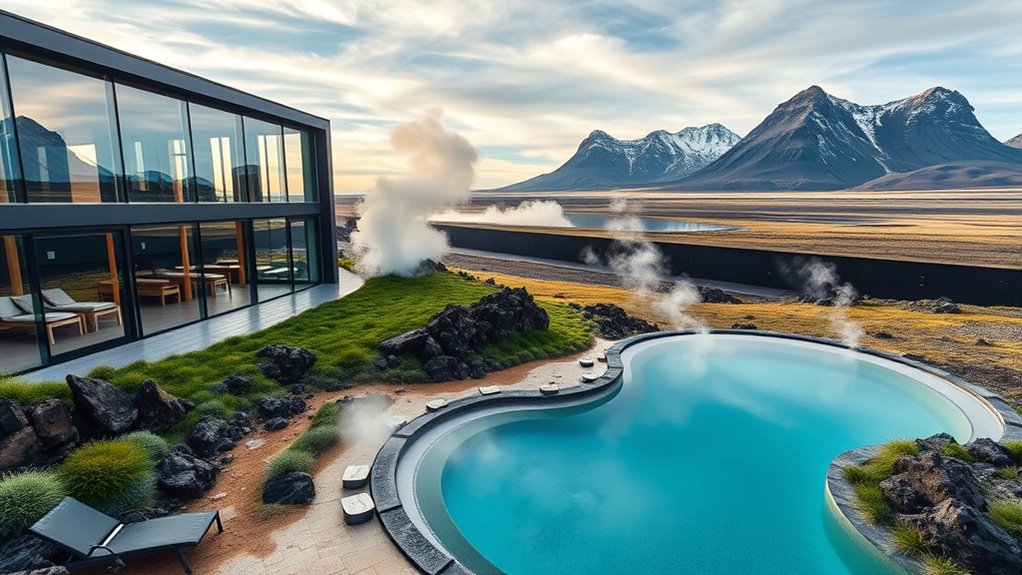
When you stay at luxury retreats in Iceland, you’ll discover how geothermal energy enhances your experience while promoting sustainability.
These retreats, like Torfhús Retreat, use local materials and geothermal heating to create a cozy atmosphere. You’ll find unique furniture crafted from repurposed Icelandic fishing boats, adding a charming touch to your accommodations.
Experience the charm of Torfhús Retreat, where repurposed fishing boat furniture and geothermal heating create a cozy, sustainable escape.
Enjoy the warmth of hot water sourced from geothermal springs, which keeps your suite comfortable and eco-friendly. Many resorts, such as the Blue Lagoon Retreat, also feature geothermal lagoons for relaxation.
Indulge in fine dining with locally sourced ingredients at Michelin-starred restaurants.
With every detail, these retreats blend luxury with responsible practices, allowing you to unwind in Iceland’s stunning natural landscapes while supporting renewable energy initiatives.
Sustainable Tourism: The Intersection of Luxury and Nature
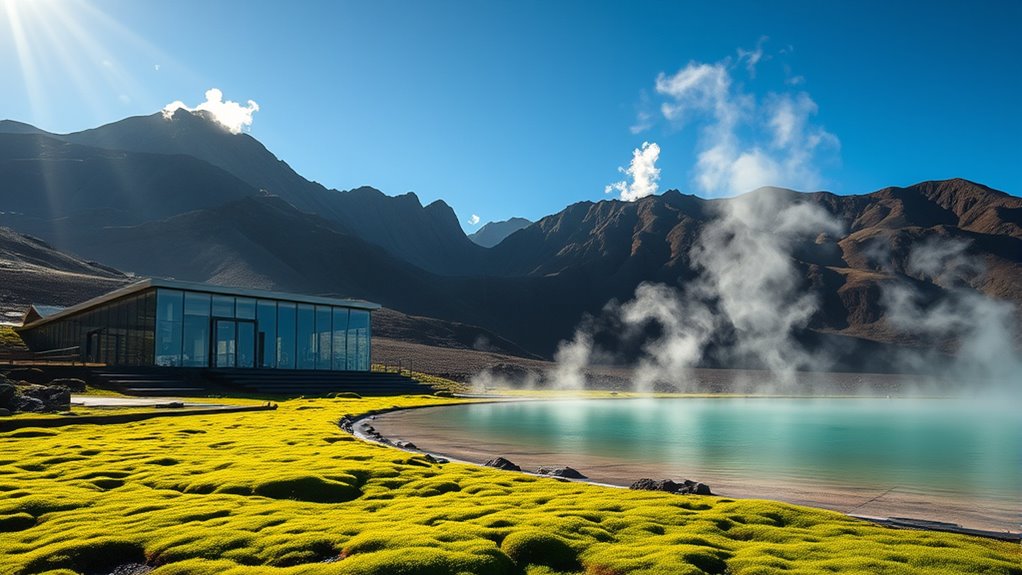
Sustainable tourism represents a harmonious blend of luxury and nature, where travelers can indulge in high-end experiences while respecting the environment.
You’ll find that today’s luxury travel emphasizes simplicity and authenticity, driven by a desire for eco-consciousness. With 95% of luxury travelers prioritizing environmental conservation, the industry is responding by adopting sustainable practices. Energy-efficient heat pumps are becoming a standard feature in luxury accommodations to optimize energy consumption while maintaining comfort.
Expect eco-friendly accommodations that utilize green technology and local sourcing, ensuring a minimal ecological footprint. You’re not just enjoying lavish amenities; you’re also engaging with local cultures and supporting community initiatives. Many luxury retreats are increasingly incorporating geothermal energy solutions, harnessing the Earth’s heat for sustainable heating and electricity generation, which can achieve efficiency ratings of 300% to 600%. This is made possible through heat pumps, which use the refrigeration cycle to efficiently transfer heat, greatly enhancing energy sustainability.
Unique Horticulture Opportunities in Geothermal Regions
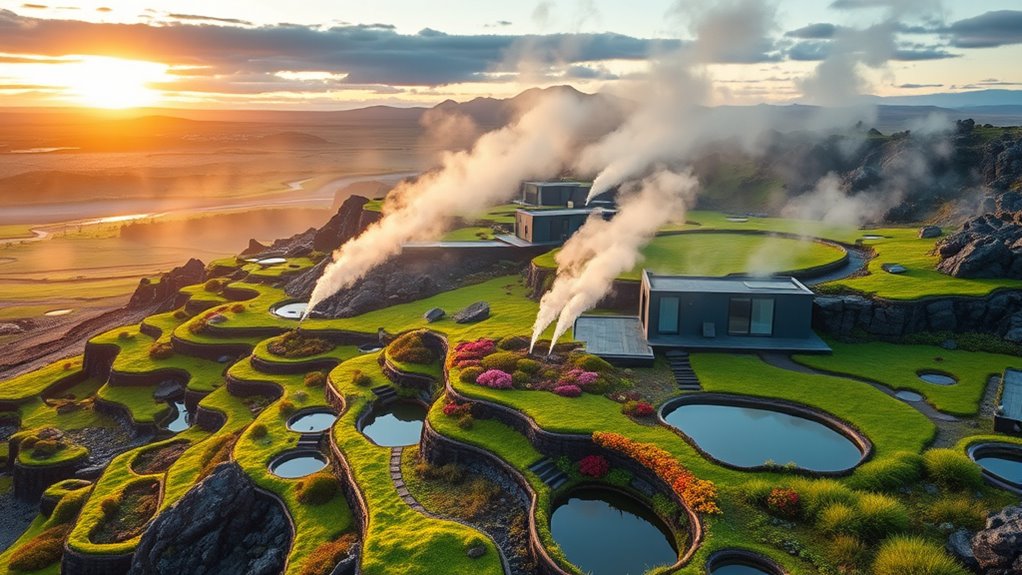
Iceland’s geothermal energy not only fuels eco-conscious tourism but also opens up unique horticulture opportunities.
With abundant geothermal resources, you’ll find that year-round cultivation of fruits, vegetables, and flowers is possible, thanks to heated greenhouses. The consistent temperatures and humidity promote healthier crops and reduce disease risks.
You’ll also enjoy significantly lower energy costs compared to traditional methods, making greenhouse operations more sustainable. Utilizing geothermal heat for soil sterilization improves soil health and reduces pathogens.
The techniques developed in Iceland can inspire horticulture in other regions with similar geothermal potential, showcasing the global application of this innovative approach. Embracing these unique horticulture opportunities can lead to a thriving agricultural industry in geothermal regions.
Geothermal Hot Springs: A Cultural Treasure

Geothermal hot springs are a cherished part of Icelandic culture, intertwining history and community in a unique way. Dating back to the Viking era, these natural wonders served as vital spaces for comfort and hygiene.
Today, they remain social hubs where locals and visitors connect, fostering conversation and camaraderie. Deeply ingrained in national identity, Iceland’s hot springs reflect a strong cultural attachment to the land.
Recognized for their significance, Icelandic bathing culture has been nominated for UNESCO’s Intangible Cultural Heritage list. With mineral-rich waters believed to offer numerous health benefits, these geothermal gems are more than just relaxing spots; they’re essential to Iceland’s heritage and well-being. Additionally, the health benefits associated with these waters highlight the importance of preserving such natural resources for future generations.
Environmental Benefits of Geothermal Energy for Luxury Resorts
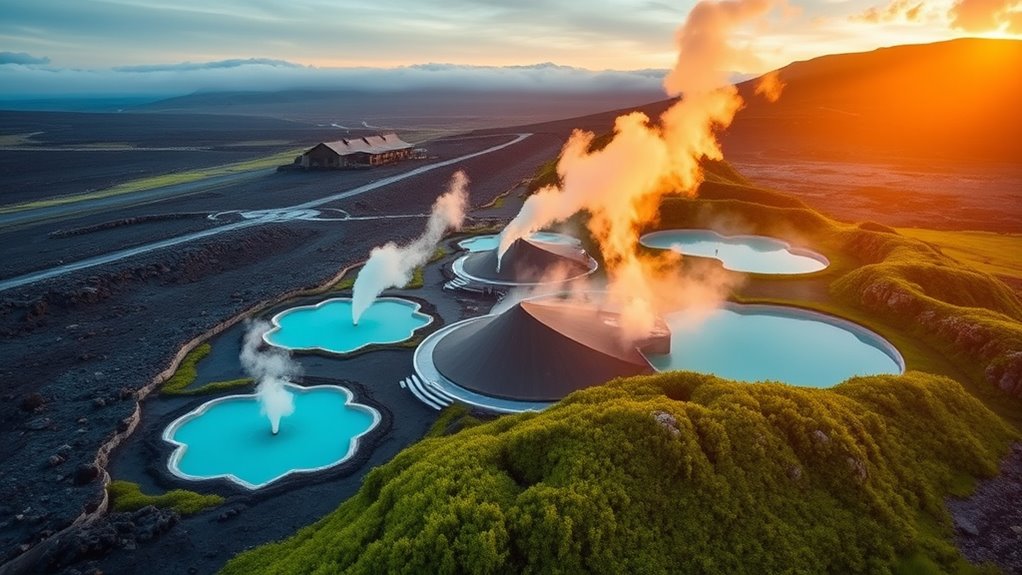
Hot springs not only embody Icelandic culture but also showcase the country’s commitment to environmental responsibility.
By utilizing geothermal energy, luxury resorts significantly minimize their carbon footprint, thereby reducing greenhouse gas emissions. You’ll find that these resorts decrease their dependence on fossil fuels, leading to cleaner environments and lower pollution levels.
Geothermal energy ensures long-term sustainability, providing a reliable energy source that won’t deplete over time. This commitment not only enhances your resort’s reputation as environmentally conscious but also attracts like-minded guests. Additionally, embracing sustainable living practices can further amplify the positive impact these resorts have on the environment.
Moreover, efficient geothermal systems lower operational costs, ensuring a consistent energy supply while boosting property value.
Ultimately, you’re participating in a sustainable tourism model that benefits both the environment and your bottom line.
The Growth of Geothermal Energy Infrastructure

A significant portion of Iceland’s energy landscape revolves around the robust growth of geothermal energy infrastructure.
You’ll find that 90% of central heating is powered by geothermal sources, while 100% of electricity comes from renewables—30% from geothermal and 70% from hydropower.
Key facilities like Hellisheiði and Svartsengi not only generate electricity but also provide heating.
The government is actively expanding geothermal exploration, particularly in cold regions and underdeveloped areas such as the Westfjords.
Innovations like the Iceland Deep Drilling Project and CCUS technologies enhance efficiency and sustainability.
Additionally, connecting rural households to geothermal district heating reduces reliance on fossil fuels, fostering community growth and economic benefits.
This infrastructure truly reflects Iceland’s commitment to renewable energy.
Challenges Facing Geothermal Energy Development

While Iceland’s geothermal energy potential is immense, several challenges threaten its development. Environmental impacts, like hydrogen sulfide emissions, can affect air quality in Reykjavik, making careful management essential.
Drilling for geothermal resources is costly and risky, complicating exploration efforts. You’ll find that existing systems are running at maximum capacity, straining under increasing demand for heating.
High startup costs and the need for specialized expertise can deter investment compared to other renewable sources. Additionally, weak regulations around pollution hinder sustainable practices.
Balancing economic benefits with environmental concerns requires updated policies and collaboration among stakeholders to navigate these complex challenges effectively. Addressing these issues is crucial for unlocking geothermal’s full potential in Iceland.
Future Prospects for Geothermal Energy and Tourism in Iceland
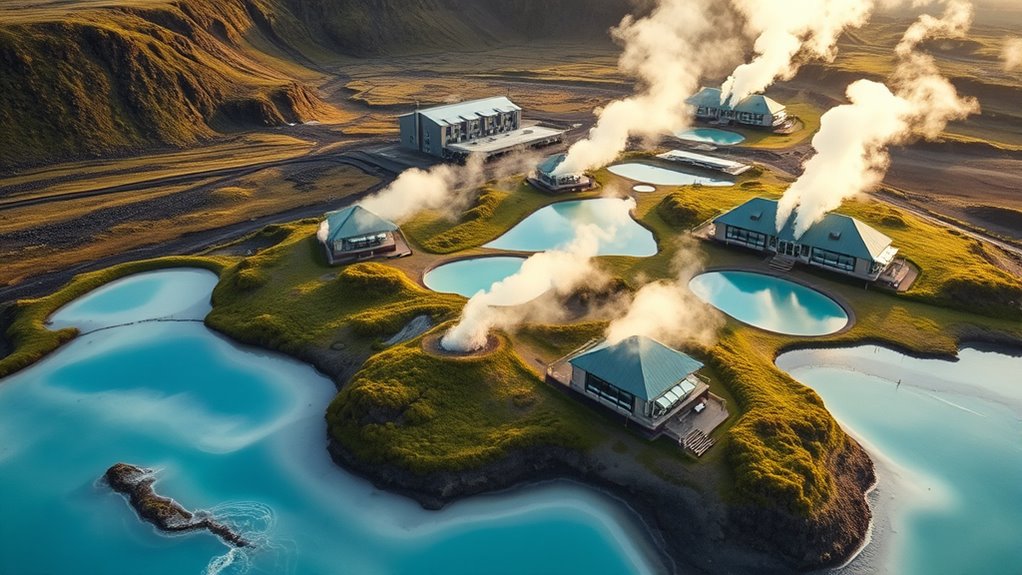
Iceland’s geothermal energy landscape is on the brink of significant transformation, driven by both technological advancements and the booming tourism sector.
You’ll see projects like the Krafla Magma Testbed enhancing energy extraction efficiency, tapping into magma for greater output.
As you explore, notice how tourism benefits from clean energy, reducing carbon footprints in hotels and transport.
Sustainable practices powered by geothermal energy bolster local economies while conserving resources.
Iceland’s innovations serve as a model globally, showcasing geothermal’s potential in combating climate change.
By visiting geothermal sites, you’ll not only experience Iceland’s culture but also gain insight into sustainable practices.
The synergy between geothermal energy and tourism promises a bright future for Iceland’s economy and environment.
Frequently Asked Questions
How Does Geothermal Energy Impact Local Wildlife in Iceland?
Geothermal energy can significantly impact local wildlife. You might notice altered habitats due to construction and resource extraction, which can disrupt ecosystems.
However, geothermal sites can also support unique microbial and plant life, creating diverse environments.
While reduced carbon emissions help combat climate change, groundwater changes and pollution from geothermal activities pose risks.
Balancing energy needs with wildlife conservation is crucial to minimizing negative effects while maximizing potential benefits for local ecosystems.
What Are the Costs Associated With Geothermal Luxury Retreats?
You might think luxury comes at an insurmountable price, but geothermal retreats offer a blend of high initial investments and long-term savings.
While building these facilities requires significant upfront costs, operational expenses are lower due to geothermal efficiency.
Prices for exclusive experiences can start high, but the unique benefits and sustainable energy sources make them worthwhile.
Plus, you’re contributing to local economies, creating jobs, and enjoying breathtaking natural surroundings.
Are There Any Risks of Geothermal Energy for Public Health?
Yes, there are risks associated with geothermal energy that can impact public health.
You might encounter exposure to toxic gases like hydrogen sulfide, which can lead to respiratory issues and cardiovascular problems.
Additionally, geothermal activities can trigger small earthquakes or cause ground instability, posing further health risks.
It’s crucial to monitor these activities closely and maintain strict safety standards to minimize potential hazards for communities living near geothermal sites.
How Does Geothermal Energy Affect Traditional Icelandic Architecture?
Geothermal energy significantly influences traditional Icelandic architecture by promoting sustainable heating methods.
You’ll notice buildings designed to harness this energy, eliminating the need for conventional heating systems. This integration encourages the use of locally sourced materials and designs that harmonize with the landscape, minimizing visual impact.
As you explore, you’ll see how architecture can preserve cultural heritage while embracing modern technology, all while aligning with Iceland’s commitment to renewable resources and environmental sustainability.
What Role Do Local Communities Play in Geothermal Energy Projects?
Local communities aren’t just players; they’re the rock stars in geothermal energy projects!
You see, they spearhead innovations and rally for sustainable practices. They’ve got the power to influence decisions and shape project outcomes, ensuring everyone benefits.
By engaging with local leaders and building trust, you help create a social license to operate.
When communities embrace these initiatives, they transform their energy landscape, paving the way for a greener, brighter future for all!
Conclusion
As you wander through Iceland’s geothermal wonders, you realize that each puff of steam and bubbling spring tells a story of balance. Just like the luxury retreats that thrive in harmony with nature, your own journey reflects a dance between indulgence and responsibility. Embracing geothermal energy isn’t just about comfort; it’s about nurturing the land for future generations. So, as you soak in the warmth, remember: true luxury lies in preserving the beauty that surrounds us.
